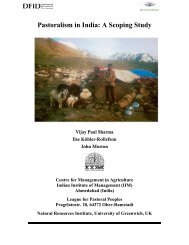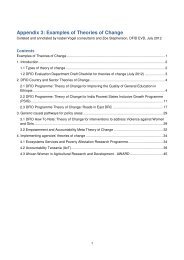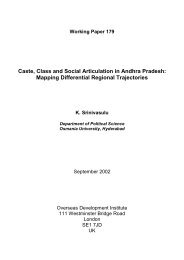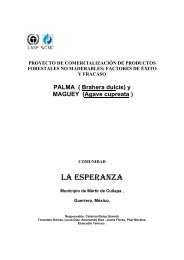Full Report - Research for Development - Department for ...
Full Report - Research for Development - Department for ...
Full Report - Research for Development - Department for ...
You also want an ePaper? Increase the reach of your titles
YUMPU automatically turns print PDFs into web optimized ePapers that Google loves.
Synthesis results<br />
order to be effective, could not operate in isolation and required continued and<br />
active involvement of healthcare staff in order to review and improve neonatal care<br />
routines.<br />
INCREASING INVESTMENT AND SCALING UP<br />
Three studies considered the impact of increasing investment and scaling up on<br />
infant mortality outcomes. The scaling up of facility-based neonatal care in a district<br />
in southern India showed benefits in perinatal and neonatal mortality (Shantharam<br />
Baliga et al., 2007) (+)/(++). Using a pre- and post-study design, the authors show a<br />
significant decline in early neonatal and perinatal mortality rates, together with a<br />
significant decline in case fatality rates <strong>for</strong> LBW, sepsis and birth asphyxia. They<br />
noted that, without sufficient community and health worker motivation, the scaling<br />
up was unlikely to have been so successful in reducing early age mortality. Similarly,<br />
Enweronu et al. (2008) (+)/(-) showed the benefits of investment in infrastructural<br />
and staff improvements in neonatal care <strong>for</strong> the survival of lower birthweight babies<br />
in Ghana. In urban Zambia, Essential Newborn Care training reduced early neonatal<br />
mortality (Chomba et al., 2008) (+)/(++). However, there was a differential impact<br />
of improved service organisation by educational status of the mother, with the<br />
greatest impact among women with no secondary education.<br />
DISCHARGE AND ADMISSION PROCEDURES IN NEONATAL UNITS<br />
Five papers involved the evaluation of improved hospital discharge and admissions<br />
procedures <strong>for</strong> neonates. Three studies considered this specifically <strong>for</strong> LBW babies,<br />
albeit with different definitions of LBW. Bhakhoo et al. (1989) (+)/(+) in India,<br />
Bhutta et al. (2004) (+)/(-) in Pakistan and Blencowe et al. (2009) (+)/(+) in Malawi<br />
all suggested that early discharge of neonates was safe and did not lead to an<br />
increase in adverse neonatal mortality outcomes. Among these, the study by<br />
Blencowe et al. (2009) (+)/(+) looked at the early discharge with Kangaroo Mother<br />
Care (KMC) as an alternative to routine hospitalisation of low-birthweight babies.<br />
The study suggested that early discharge was safe and feasible and that, if rolled out<br />
to all levels of health facilities, Kangaroo Mother Care might help to overcome<br />
existing problems in access to care. Agarwal et al. (2007b) also looked early<br />
discharge and rational admissions among other low-cost interventions in a resourcelimited<br />
teaching hospital in India. The findings of the study suggested that simple<br />
interventions such as these could result in a significant decline of neonatal<br />
mortality.<br />
In an Indian-based study, Sasidharan et al. (2005) (-)/(-) looked wider than<br />
admissions and discharges and considered the impact of changed practices in terms<br />
of maternal and newborn contact <strong>for</strong> high-risk neonates in a hospital newborn unit.<br />
Prior to the intervention, mothers and their newborns were physically separated,<br />
with only occasional breastfeeding permitted. The intervention changed this regime,<br />
and permitted mothers (or their substitutes) to breastfeed on demand, alongside<br />
other service changes. This can be categorised as a low-cost intervention where<br />
increased maternal involvement in the neonatal period proved to be successful in<br />
reducing neonatal mortality.<br />
KANGAROO MOTHER CARE<br />
A total of six studies specifically addressed Kangaroo Mother Care (KMC), which is a<br />
method of care <strong>for</strong> preterm infants usually involving the infant being carried by the<br />
mother, with skin to skin contact (World Health Organization, 2003). The study by<br />
Colonna et al. (1990) (-)/(-) in urban Mozambique recommended KMC as a low-cost<br />
effective intervention. Three other papers were specifically on KMC as a method of<br />
infant care rather than simply service reorganisation. Whilst Lincetto et al. (2000)<br />
reported significant reductions in neonatal mortality following the introduction of<br />
KMC in a low-resource setting in Mozambique, evidence from the other studies was<br />
What are the effects of different models of delivery <strong>for</strong> improving maternal and infant health<br />
outcomes <strong>for</strong> poor people in urban areas in low income and lower middle income countries? 37









